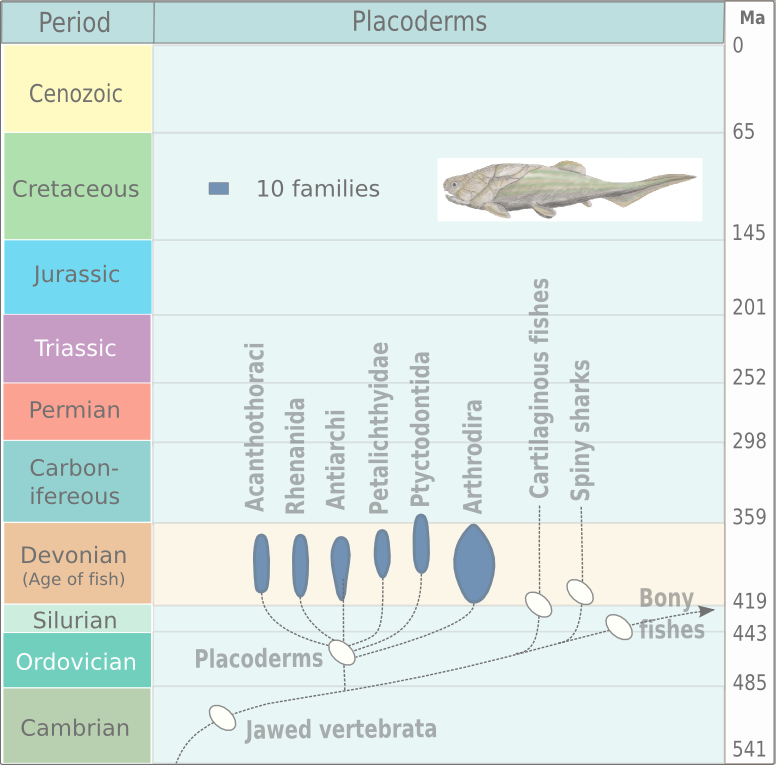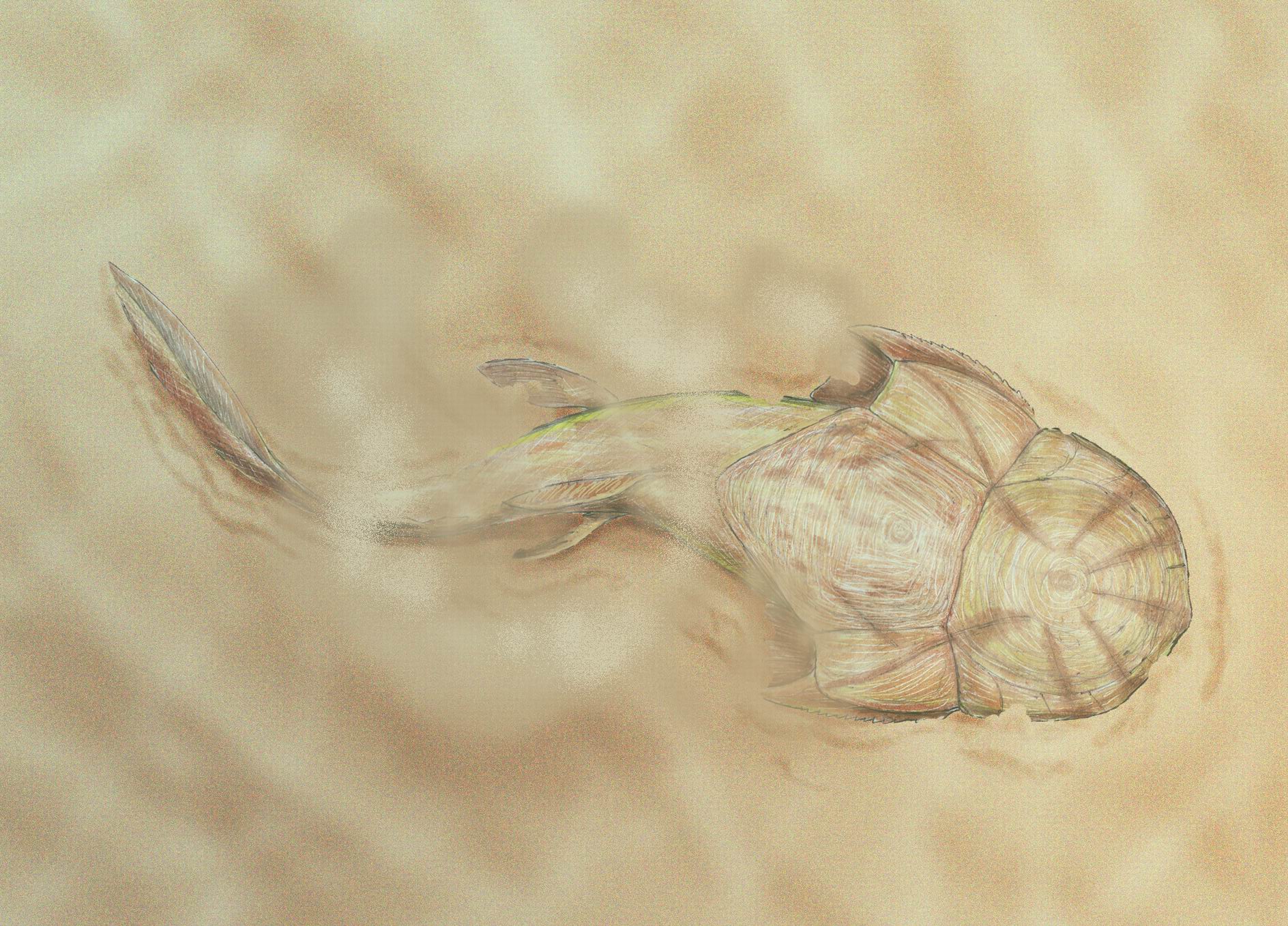|
Pseudopetalichthyida
Pseudopetalichthyida is an order of lightly armored placoderms known only from rare fossils in Lower Devonian strata in Hunsrück, Germany. Like '' Stensioella heintzi'', and the Rhenanida, the Pseudopetalichthids had armor made up of a mosaic of tubercles. Like '' Stensioella heintzi'', the Pseudopetalichthids' placement within Placodermi is suspect. However, due to a gross lack of whole, uncrushed, articulated specimens, there are no other groups that the Pseudopetalichthids could be, for a lack of a better word, pigeonholed into. On the other hand, according to anatomical studies done on the crushed specimens that have been found, those experts who do regard the Pseudopetalichthyida as placoderms consider them to be a group more advanced than the Ptyctodonts. And as such, pro-placoderm experts consider Pseudopetalichthyida to be the sister group of the Arthrodires + Phyllolepida + Antiarchi trichotomy and the Acanthothoraci + Rhenanida dichotomy. The best known spec ... [...More Info...] [...Related Items...] OR: [Wikipedia] [Google] [Baidu] |
Placoderm Orders
Placoderms (from Ancient Greek πλάξ [''plax'', ''plakos''] 'Plate (animal anatomy), plate' and δέρμα [''derma''] 'skin') are vertebrate animals of the class (biology), class Placodermi, an extinct group of prehistoric fish known from Paleozoic fossils during the Silurian and the Devonian geological period, periods. While their endoskeletons are mainly cartilaginous, their head and thorax were covered by articulated armour (zoology), armoured plates (hence the name), and the rest of the body was scale (zoology), scaled or naked depending on the species. Placoderms were among the first jawed fish (their fish jaw, jaws likely Evolution, evolved from the first pair of gill arches), as well as the first vertebrates to have true tooth, teeth. They were also the first fish clade to develop pelvic fins, the second set of paired fins and the homology (biology), homologous precursor to hindlimbs in tetrapods. 380-million-year-old fossils of three other genera, ''Incisoscutum'', ''M ... [...More Info...] [...Related Items...] OR: [Wikipedia] [Google] [Baidu] |
Pseudopetalichthyida
Pseudopetalichthyida is an order of lightly armored placoderms known only from rare fossils in Lower Devonian strata in Hunsrück, Germany. Like '' Stensioella heintzi'', and the Rhenanida, the Pseudopetalichthids had armor made up of a mosaic of tubercles. Like '' Stensioella heintzi'', the Pseudopetalichthids' placement within Placodermi is suspect. However, due to a gross lack of whole, uncrushed, articulated specimens, there are no other groups that the Pseudopetalichthids could be, for a lack of a better word, pigeonholed into. On the other hand, according to anatomical studies done on the crushed specimens that have been found, those experts who do regard the Pseudopetalichthyida as placoderms consider them to be a group more advanced than the Ptyctodonts. And as such, pro-placoderm experts consider Pseudopetalichthyida to be the sister group of the Arthrodires + Phyllolepida + Antiarchi trichotomy and the Acanthothoraci + Rhenanida dichotomy. The best known spec ... [...More Info...] [...Related Items...] OR: [Wikipedia] [Google] [Baidu] |
Placoderm
Placoderms (from Ancient Greek πλάξ [''plax'', ''plakos''] 'Plate (animal anatomy), plate' and δέρμα [''derma''] 'skin') are vertebrate animals of the class (biology), class Placodermi, an extinct group of prehistoric fish known from Paleozoic fossils during the Silurian and the Devonian geological period, periods. While their endoskeletons are mainly cartilaginous, their head and thorax were covered by articulated armour (zoology), armoured plates (hence the name), and the rest of the body was scale (zoology), scaled or naked depending on the species. Placoderms were among the first jawed fish (their fish jaw, jaws likely Evolution, evolved from the first pair of gill arches), as well as the first vertebrates to have true tooth, teeth. They were also the first fish clade to develop pelvic fins, the second set of paired fins and the homology (biology), homologous precursor to hindlimbs in tetrapods. 380-million-year-old fossils of three other genera, ''Incisoscutum'', ''M ... [...More Info...] [...Related Items...] OR: [Wikipedia] [Google] [Baidu] |
Placodermi
Placoderms (from Ancient Greek πλάξ 'plax'', ''plakos''' plate' and δέρμα 'derma'''skin') are vertebrate animals of the class Placodermi, an extinct group of prehistoric fish known from Paleozoic fossils during the Silurian and the Devonian periods. While their endoskeletons are mainly cartilaginous, their head and thorax were covered by articulated armoured plates (hence the name), and the rest of the body was scaled or naked depending on the species. Placoderms were among the first jawed fish (their jaws likely evolved from the first pair of gill arches), as well as the first vertebrates to have true teeth. They were also the first fish clade to develop pelvic fins, the second set of paired fins and the homologous precursor to hindlimbs in tetrapods. 380-million-year-old fossils of three other genera, '' Incisoscutum'', '' Materpiscis'' and '' Austroptyctodus'', represent the oldest known examples of live birth. Placoderms are thought to be paraphyletic ... [...More Info...] [...Related Items...] OR: [Wikipedia] [Google] [Baidu] |
Paraplesiobatis Heinrichsi
''Paraplesiobatis heinrichsi'' is a lightly armored pseudopetalichthyid placoderm from the Hunsrückschiefer Lagerstätte of Early Devonian Germany. The type and only known specimen is an articulated, but very incomplete individual consisting of a large, incomplete, plate-covered head, and some of the vertebral column, with a total length of 10 centimeters. The specimen strongly resembles '' Pseudopetalichthys'' to the point that many experts suggest they may be of the same genus or species, though because the only specimens of both genera are so poorly preserved, talk of synonymizing the two can not begin (let alone continue) until more, better preserved specimens are found. References External links ''Pseudopetalichthys''at the Paleobiology Database The Paleobiology Database (PBDB) is an online resource for information on the distribution and classification of fossil animals, plants, and microorganisms. History The Paleobiology Database originated in the NCEAS-funded P ... [...More Info...] [...Related Items...] OR: [Wikipedia] [Google] [Baidu] |
Pseudopetalichthys
''Pseudopetalichthys problematica'' is a lightly armored pseudopetalichthyid placoderm from the Hunsrückschiefer Lagerstätte of Early Devonian Germany. The holotype and only known specimen is an articulated, but incomplete individual consisting of a large, mostly intact, plate-covered head, the bases of the pectoral fins, and most of the vertebral column, with a total length of . The specimen superficially resembles ''Stensioella'', though the structures of the mouth, and orbits (the orbits being unknown in ''Stensioella''), and placement of the gill rakers all differ. Some experts suggest that ''P. problematica'' and the related '' Paraplesiobatis'' are the same species, suggesting that the differences between them are merely due to different circumstances of taphonomy, but this hypothesis can not be tested until more specimens are found. The holotype was originally held in the Schlosspark Museum in Bad Kreuznach, but was then lost at an unknown date. References Externa ... [...More Info...] [...Related Items...] OR: [Wikipedia] [Google] [Baidu] |
Paraplesiobatis
''Paraplesiobatis heinrichsi'' is a lightly armored pseudopetalichthyid placoderm from the Hunsrückschiefer Lagerstätte of Early Devonian Germany. The type and only known specimen is an articulated, but very incomplete individual consisting of a large, incomplete, plate-covered head, and some of the vertebral column, with a total length of 10 centimeters. The specimen strongly resembles ''Pseudopetalichthys'' to the point that many experts suggest they may be of the same genus or species, though because the only specimens of both genera are so poorly preserved, talk of synonymizing the two can not begin (let alone continue) until more, better preserved specimens are found. References External links ''Pseudopetalichthys''at the Paleobiology Database The Paleobiology Database (PBDB) is an online resource for information on the distribution and classification of fossil animals, plants, and microorganisms. History The Paleobiology Database originated in the NCEAS-funded Ph ... [...More Info...] [...Related Items...] OR: [Wikipedia] [Google] [Baidu] |
Nessariostoma
''Nessariostoma granulosum'' is a lightly armored pseudopetalichthyid placoderm from the Hunsrückschiefer Lagerstätte of Early Devonian Germany. The type and only known specimen is an articulated, but very incomplete individual, deformed and elongated, consisting of a large, incomplete, tubercle-covered head, a long, beak-like rostrum, and some of the trunk, with a total length of 18 centimeters. ''N. granulosum'' was once placed in Stensioellida, though most other experts regard it at as a pseudopetalichthyid: Denison 1978 regards it as a placoderm ''incertae sedis'' because the specimen is deformed and so poorly preserved so as to stymie proper attempts at classification. References External links ''Pseudopetalichthys''at the Paleobiology Database The Paleobiology Database (PBDB) is an online resource for information on the distribution and classification of fossil animals, plants, and microorganisms. History The Paleobiology Database originated in the NCEAS-funded ... [...More Info...] [...Related Items...] OR: [Wikipedia] [Google] [Baidu] |
Pseudopetalicthys Problematica
''Pseudopetalichthys problematica'' is a lightly armored pseudopetalichthyid placoderm from the Hunsrückschiefer Lagerstätte of Early Devonian Germany. The holotype and only known specimen is an articulated, but incomplete individual consisting of a large, mostly intact, plate-covered head, the bases of the pectoral fins, and most of the vertebral column, with a total length of . The specimen superficially resembles ''Stensioella'', though the structures of the mouth, and orbits (the orbits being unknown in ''Stensioella''), and placement of the gill rakers all differ. Some experts suggest that ''P. problematica'' and the related ''Paraplesiobatis'' are the same species, suggesting that the differences between them are merely due to different circumstances of taphonomy, but this hypothesis can not be tested until more specimens are found. The holotype was originally held in the Schlosspark Museum in Bad Kreuznach, but was then lost at an unknown date. References External ... [...More Info...] [...Related Items...] OR: [Wikipedia] [Google] [Baidu] |
Acanthothoraci
Acanthothoraci (''spine chests'') is an extinct group of chimaera-like placoderms closely related to the rhenanid placoderms. Superficially, the acanthoracids resembled scaly chimaeras and (relatively) heavily armored ptyctodonts. They were distinguished from chimaeras by their large scales and plates, a pair of large spines that emanate from their chests (thus, the order's name), tooth-like beak plates, and the typical bone-enhanced placoderm eyeball. They were distinguished from other placoderms by differences in skull anatomy and by patterns on the skull plates and thoracic plates that are unique to this order. Fossil record Fossils of the acanthothoracids are found in various deposits from the Lower Devonian throughout the world. Fossils of the Palaeacanthaspids are found in Eurasia and Canada, while the Weejasperaspids have only been found in the Taemas Wee Jasper reef, in Southeastern Australia. Ecology From what can be inferred from the mouthplates of fossil specim ... [...More Info...] [...Related Items...] OR: [Wikipedia] [Google] [Baidu] |
Phyllolepida
Phyllolepida ("leaf scales") is an extinct taxon of flattened placoderms found throughout the world, with fossils being found in Devonian strata. Like other flattened placoderms, the phyllolepids were bottom-dwelling predators that ambushed prey. Unlike other flattened placoderms, the phyllolepids were inhabitants of freshwater environments. Unlike the Rhenanida, the armor of the phyllolepids were made of whole plates, rather than numerous tubercles and scales, and unlike the Petalichthyida, the components of the comparatively wide mouth are known. The phyllolepids are considered to have been blind, as the orbits for the eyes are extremely small, so much so as to suggest that the eyes were vestigial, and that they were placed on the sides of the head, as opposed to visually-oriented bottom-dwelling predators, like, say stargazers or flatfish, which have the eyes placed high on top of the head. Despite having a relatively clear idea of the phyllolepids' lifestyle and anatomy, ... [...More Info...] [...Related Items...] OR: [Wikipedia] [Google] [Baidu] |



